With its luscious, dark green leaves and striking white veins, Alocasia Sarian makes for an unforgettable living work of art in your home. There’s no doubt that this plant has the “it” factor, and will surely have your guests asking, “Wow, what kind of plant is that?”
As you unleash your inner plant parent, we’ll guide you through everything you need to know about this exotic, low-maintenance houseplant. From Alocasia Sarian care requirements to tips and tricks for making this beauty thrive, we’ll cover it all.
Table of Contents
Alocasia Sarian Plant Care Guide
History, Habitat, and Characteristics
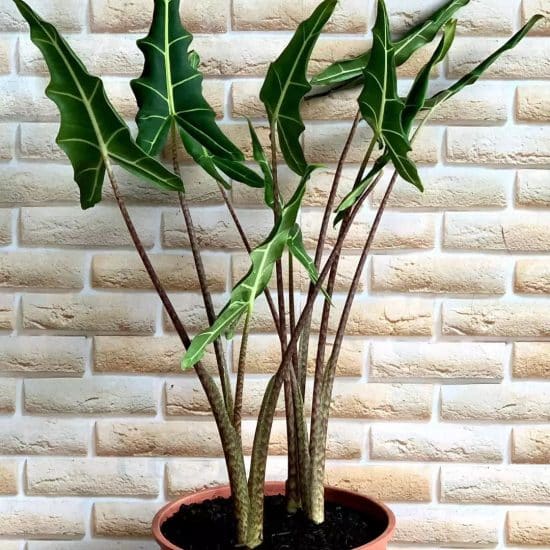
Alocasia Sarian (Alocasia zebrina × Alocasia micholitziana) is an eye-catching tropical plant with an intriguing history and background to ‘leaf’ you in awe. This plant is the love child of two unique alocasia species from Southeast Asia, combining their distinct characteristics to create this captivating hybrid.
The Alocasia Sarian was named in honor of Zac B. Sarian, a well-known agriculture journalist from the Philippines. Introduced to the world around 15 years ago, this plant has been turning heads ever since, thanks to its one-of-a-kind appearance.
What sets the Alocasia Sarian apart from its relatives is its striking foliage. With large, dark green, arrow-shaped leaves that are firm and leathery, it puts its more delicate alocasia cousins in the shade. These leaves are accentuated by their prominent whitish-to-yellowish veins.
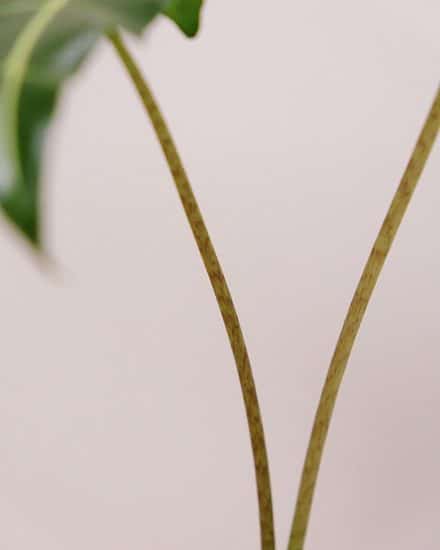
The Alocasia Sarian’s patterned stems also deserve a standing ovation. Seemingly hand-painted, these intricate designs make the plant truly unique.
Alocasia sarian is a tuberous plant, meaning it grows from a central storage organ called a tuber or rhizome. This allows an alocasia plant to store water and nutrients, providing it with the ability to withstand periods of drought or unfavorable conditions. It also gives us insight to how we’ll propagate this plant — as it matures, it produces numerous pups along its sides.
Outdoors, this plant can grow more than 8 feet tall. As an indoor plant, it’s typically a bit more restrained, but it likely will become the statement piece or focal point in a bright, spacious room.
Alocasia sarian vs Alocasia zebrina
Alocasia Sarian is a cross between Alocasia zebrina and Alocasia micholitziana. While the three plants share some common features, such as their striking foliage and preference for similar growing conditions, they have distinctive characteristics that set them apart.
The leaves of Alocasia Sarian are a blend of traits from its two parents. While the arrow-shaped leaf blade is common to both parents, Alocasia Sarian gets its unique zebra-striped stems from Alocasia zebrina, and its prominent yellow to cream-colored veins from Alocasia micholtziana. Alocasia zebrina doesn’t have veins in its leaves, which are solid green, and has straight leaf edges, unlike the serrated ones of Alocasia Sarian.
Light
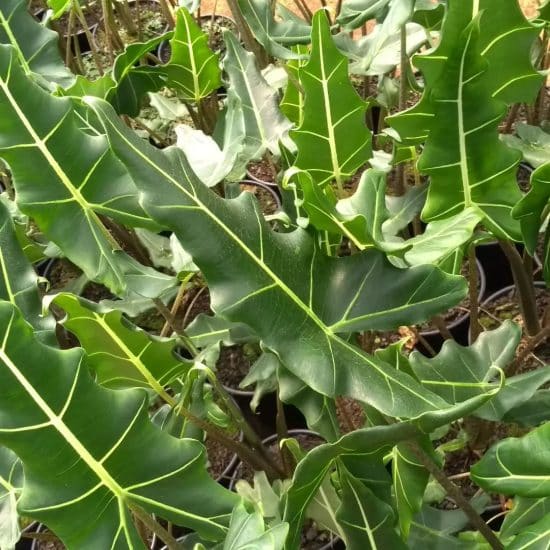
In their natural tropical and subtropical habitats, many alocasia plants enjoy the dappled light found on the forest floor. You’ll want to replicate this environment when growing Alocasia Sarian to keep it happy. Choose a spot for your Alocasia Sarian that offers partial shade and filtered sunlight, steering clear of direct afternoon sun.
Alocasia Sarian will happily soak up 3 to 4 hours of gentle morning sunlight, but it’s crucial to protect it from the harsh rays of the afternoon sun, which can cause damage and burn its leaves.
If you notice slow growth or yellowing leaves, your plant may need more light. Try moving it to a brighter location or using a grow light (an LED, full-spectrum light is ideal) to supplement the natural light.
Scorched, faded leaves or small brown patches are indicators of too much direct sun. Soften the light by adding a sheer curtain or moving the plant to a spot with less direct light.
Water
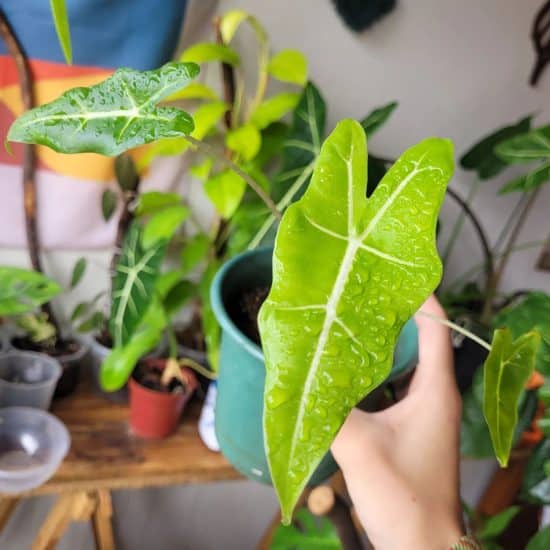
To determine when this tropical plant needs water, poke your finger about two inches into the soil along the sides (this is a useful trick for most plants).
If the soil is dry, it’s time to water. If you feel moist soil, wait until it dries out a little more. The goal is to achieve lightly watered soil that strikes a balance between hydration and saturation.
If your Alocasia Sarian is not receiving enough water, you’ll notice browning and yellowing leaf tips. This is a good sign to increase your watering frequency.
On the other hand, if the plant is receiving too much water, you might see the leaves collapsing or turning yellow. You’ll want to reassess your watering routine and allow the soggy soil to dry out a bit before watering again.
Alocasia plants can sometimes be sensitive to water quality. We recommend using room-temperature filtered tap water, or distilled water if available.
Temperature and Humidity
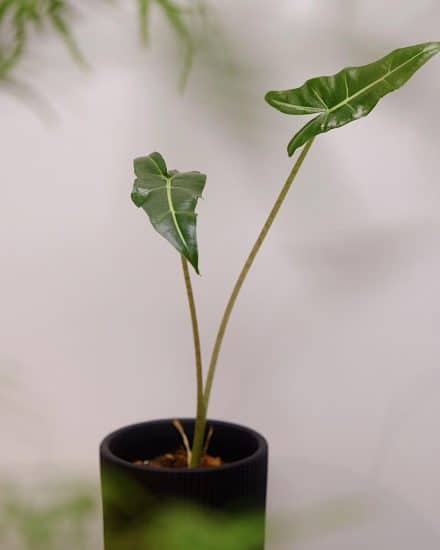
Alocasia Sarian will thrive in temperatures between 60-85°F. Wilting or drooping leaves and discolored foliage can be a sign that the temperature is either too low or too high, so keep this plant away from cold drafts, radiators, and air conditioning vents.
Extremely cold temperatures can lead to sudden leaf loss, so take care when bringing this plant home from a nursery if it’s a bit chilly out.
Alocasia Sarian enjoys a moderately humid environment, showing vibrant plant growth with indoor humidity levels of 40-60%. Curling or brown leaf edges are a sign of low humidity, while yellow leaves or mold growth may suggest excessive humidity.
To raise humidity:
- Place a pebble tray under your Alocasia Sarian. As water evaporates from the tray, it can increase the humidity around the plant by as much as 4-7%.
- Group your alocasia with other humidity-loving plants to share benefits from collective transpiration.
- Use a humidifier for a few hours each day nearby.
Soil and Planting
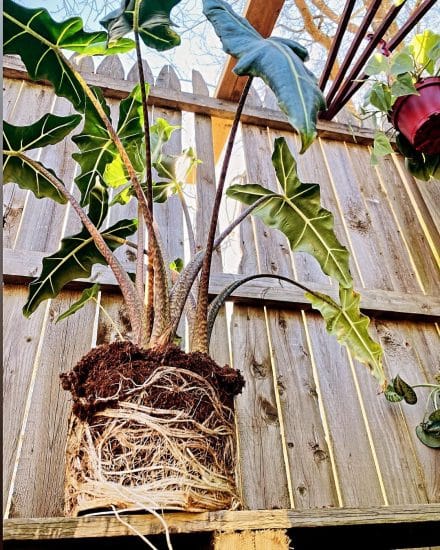
To create an ideal potting mix for your alocasia plant, consider adding coco peat and perlite to an organic potting soil. Each of these ingredients plays a crucial role in promoting a healthy environment for your plant.
Organic potting soil provides essential nutrients and minerals for your fast-growing plant to thrive. You can also try a succulent mix, since it has similar characteristics to the recommended soil combination.
Coco peat helps retain moisture and nutrients while also promoting good drainage and aeration for the root system, so that we avoid an overly heavy soil mixture.
Perlite improves soil structure, helping with moisture retention while also promoting drainage and preventing root rot.
Repotting
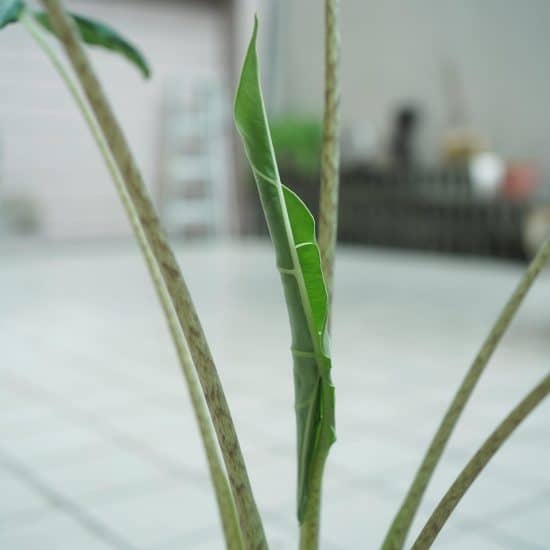
Alocasia Sarian will need repotting every two to three years, or when it outgrows its current container. Select a pot slightly larger than the previous one, making sure that it has drainage holes. Gently transfer the root ball into the new pot and carefully fill around it with the chosen soil mix.
Avoid packing the soil too tightly, and brush any excess soil away.
Transplant shock can happen as your plant adjusts to the new environment, which may result in a few leaves dropping. To minimize this risk, keep the soil moist during the first few weeks after repotting.
Since this is a rhizomatous plant, if you’re looking to propagate, this is a perfect opportunity to inspect those pups.
(We’ll cover propagation in a moment).
Fertilizer
Fertilize your plant regularly throughout the growing season, which is when it’s actively producing new growth. Be cautious not to over-fertilize, which may lead to yellowing leaves, slow growth, or a wilted appearance, even with adequate watering. As leaves attempt to push excess salts out, you’ll notice chemical burns on their edges.
If these symptoms occur, flush the soil with water to remove excess fertilizer salts, and hold off for a few weeks before fertilizing again.
We typically recommend avoiding a slow-release fertilizer or granules. Instead, we prefer to fertilize with water so that you can dilute according to the season and speed of growth.
Propagation
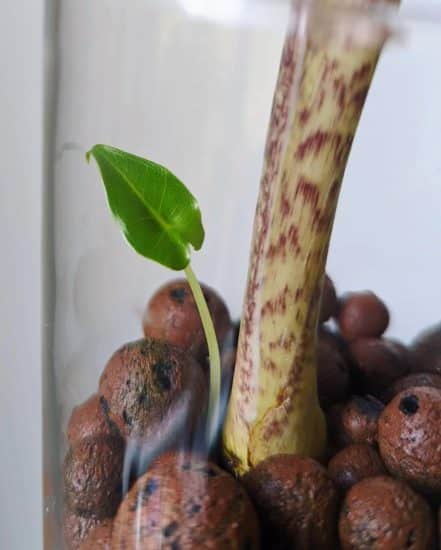
Unlike many other tropical plants, with Alocasia Sarian, stem cuttings via soil propagation have a pretty low success rate. We recommend propagating this plant through basal offset division from the mother plant.
Propagating Alocasia Sarian via basal offset division:
- Carefully take the mother plant out of its pot: Gently remove your Alocasia Sarian from its container, being mindful not to damage the roots. If the plant is root-bound, use gentle force to get it out, handling it as delicately as possible.
- Find the offsets: Look for small basal offsets growing around the plant’s base (you’ll spot offshoots that grow from a bud).
- Detach the offsets from the parent plant: Use sterilized gardening shears or a sharp knife to carefully remove the offsets. Make sure to include some roots with each offset so they can establish more easily in their new homes.
- Pot the offsets: Fill each offset’s new pot with a well-draining potting mix and create a small hole in the center. Carefully place the offset with its roots into the hole and cover it with the soil. Gently pat the soil down to secure it in place.
- Water and care for your new plants: Give the newly potted offsets a good drink of water, ensuring the soil is moist but not waterlogged. Find a spot with indirect light to place them in and continue to care for them as you would the parent plant.
Our propagation tips:
- Patience is key when waiting for the offsets to grow. It may take a little while for them to become established and start showing new growth.
- Pay attention to the offsets’ watering needs, as they might need more frequent watering than the parent plant. Be careful not to overwater, though, as this could lead to root rot.
- Propagate during Alocasia Sarian’s active growing season (spring, summer) for the best chance of success. During this time, the plant will have more energy for producing new growth.
Common issues
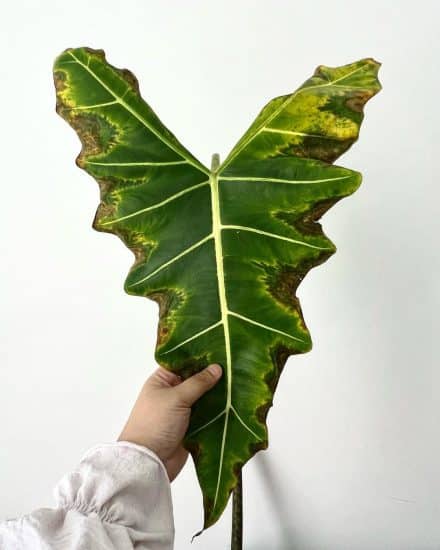
To keep Alocasia Sarian healthy and happy, keep an eye out for these common issues and learn how to tackle them effectively.
Yellowing Leaves
This issue may be caused by overwatering or underwatering your alocasia plant. To figure out which one is the culprit, examine the moisture level of the soil.
If the soil is consistently wet, overwatering might be the problem. Allow the soil to dry out a bit between waterings and consider repotting using fresh soil with better drainage to reduce waterlogging.
If the soil is dry, water it thoroughly. Be sure to give your plant a good drink each time you water, so that the soil is saturated but not soaking wet.
Dropping Leaves
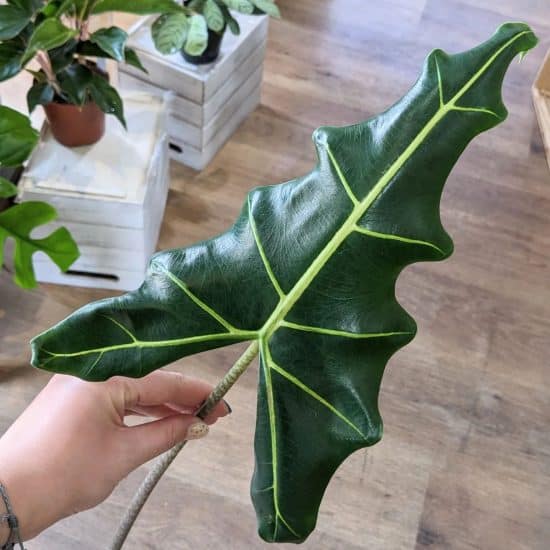
Is your Alocasia Sarian shedding leaves? Insufficient light may be to blame. These fast-growing plants need plenty of indirect sunlight to thrive and retain their glossy green leaves. To solve this issue, move your plant to a brighter spot, being careful to avoid direct sunlight.
Don’t worry too much about older leaves — they’re the first to droop and eventually drop. Simply prune them away to allow the plant to focus its energy on growing fresh, vibrant leaves that’ll make you (and your alocasia) proud.
If you notice dropping leaves after bringing your plant home or soon after turning your AC on for the summer, it may be from exposure to very cold temperatures.
Pests and Diseases
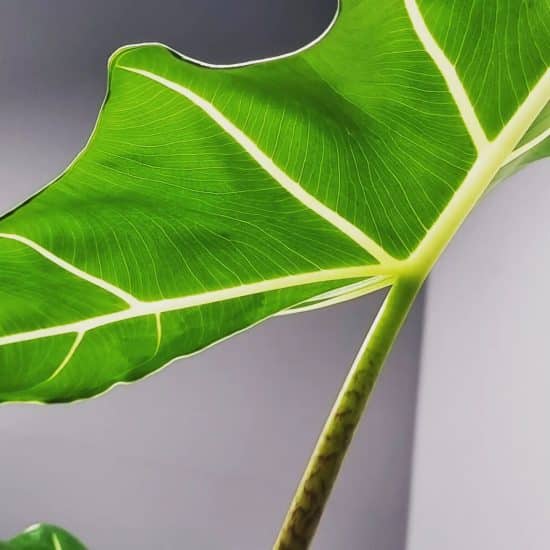
Don’t worry if your Alocasia Sarian faces issues with pests or diseases. We’re here to help you recognize the signs and offer guidance to keep your plant in tiptop shape.
Leaf Rot and Fungal Infection
High humidity and poor air circulation can lead to leaf rot and fungal infection on your Alocasia Sarian. Keep an eye out for discolored, wilting, or mushy leaves with black or brown spots.
If you do discover these symptoms, quickly trim away the affected parts of the plant to prevent the issue from spreading. Remember, cleanliness is key — wiping the leaves with a damp cloth or tissue regularly can prevent a lot of problems.
Spider Mites and Aphids
If spider mites or aphids find their way to your Alocasia Sarian, you’ll want to address the problem quickly, as they can damage your plant by sucking out essential nutrients.
Keep an eye out for these tiny pests, their webbing, and discolored spots on the leaves and stems. If you spot any of these, isolate your Alocasia Sarian to avoid spreading the pests to other plants. Use a damp cloth to remove them from affected areas and consider applying an insecticide or neem oil as a treatment.
To keep those pesky pests at bay, make sure your alocasia gets adequate light and maintain a clean environment (a little effort goes a long way).
Conclusion
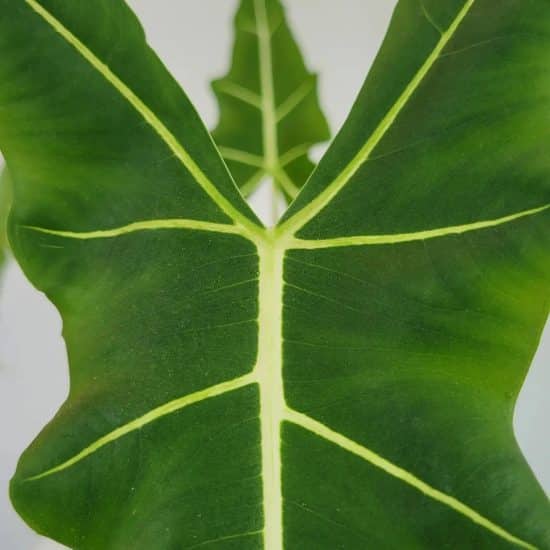
That wraps up our Alocasia Sarian care guide! Now, you should be well-equipped to grow and care for this magnificent plant and impress your friends with its stunning appearance.
Alocasia Sarian care summary:
- Provide bright, indirect light, avoiding harsh afternoon sun to prevent leaf burn.
- Maintain a temperature range of 60-85°F and a humidity level of 40-60% for optimal growth.
- Use a well-draining soil mix consisting of coco peat, perlite, and an organic potting soil.
- Fertilize during the growing season, keeping an eye on your plant and adjusting the fertilizing regime if necessary.
- Repot every 2-3 years or when the plant outgrows its current container. Transplant it into a slightly larger pot, making sure it has drainage holes.
- Keep an eye on potential issues like yellowing or dropping leaves, pests, and diseases, and address them promptly to ensure your Alocasia Sarian remains healthy and thriving.
We hope this guide has been helpful in your Alocasia Sarian journey. Don’t be shy to share your plant’s progress with us, and feel free to reach out with any questions about this or any other houseplant.
Take care and happy growing!
FAQ
How big do Alocasia Sarian get?
Alocasia Sarian can reach impressive sizes, with some plants growing up to 6 to 8 feet tall and 3 to 5 feet wide (in optimal growing conditions, of course!). The size of an Alocasia Sarian depends on factors like the age of the plant, the pot size, and the care it receives.
To encourage healthy growth, provide your Alocasia Sarian with well-draining soil, moderate humidity, and adequate light. To manage the size of your plant, you can choose to repot it into a larger container as it grows (just be careful not to disturb its roots too much during the process).
What is the difference between Alocasia sanderiana and Sarian?
While Alocasia Sarian and Alocasia sanderiana are both members of the Alocasia family, they have their own unique characteristics. Alocasia sanderiana is smaller in size compared to Alocasia Sarian. It typically grows up to 2 to 3 feet tall and features dark green, heavily veined leaves that have a striking, wavy edge.
On the other hand, Alocasia Sarian can grow up to 6 to 8 feet tall. Its leaves are large, arrowhead-shaped, and sport a mix of green and silver-blue hues. The foliage of Alocasia Sarian also has distinct yellow to cream-colored veins.


